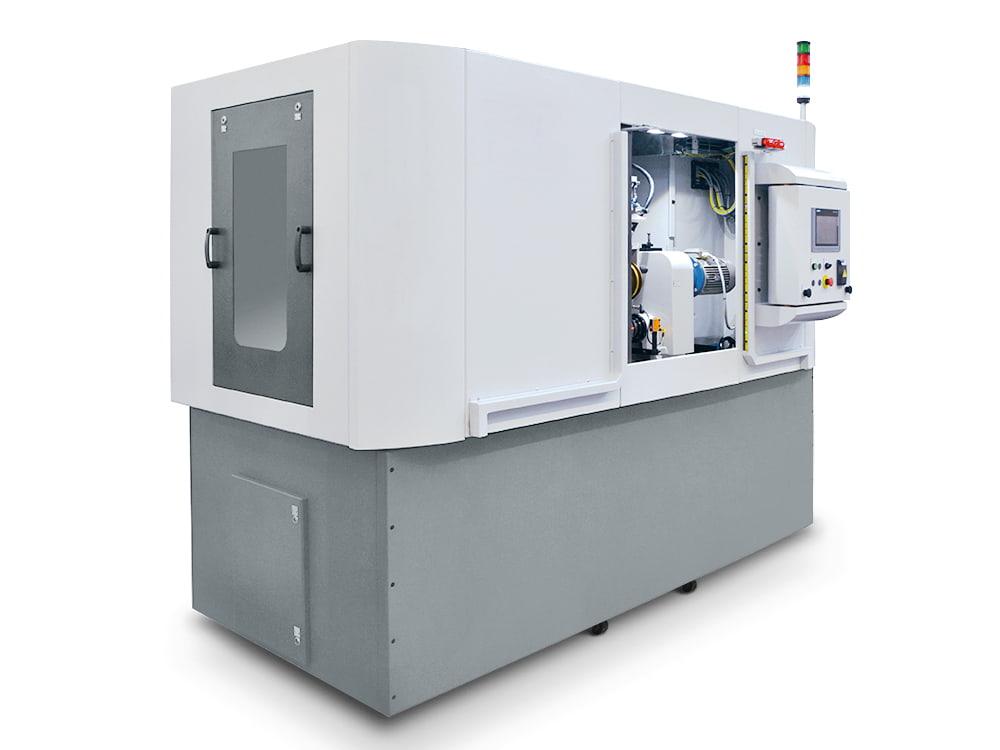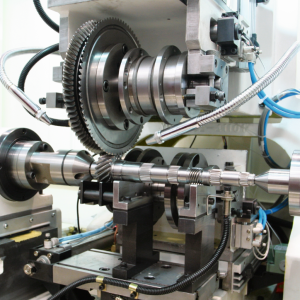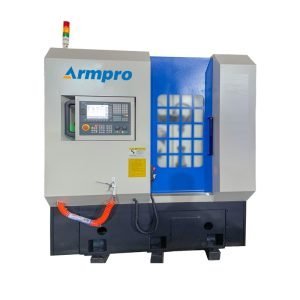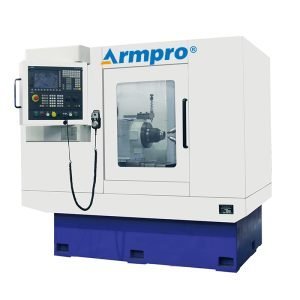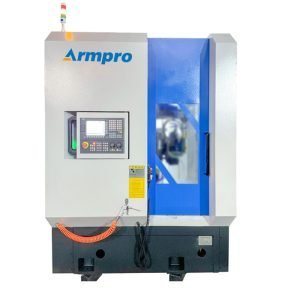Exploring the Role of CNC Gear Chamfering Machines in Automotive and Aerospace Industries
Introduction
CNC (Computer Numerical Control) gear chamfering machines play a vital role in ensuring quality and performance for critical components used in CNC automotive and CNC aerospace applications. As experienced CNC machining professionals, we have seen firsthand how chamfering takes gear manufacturing to the next level. In this article, we’ll explore what exactly CNC gear chamfering entails and why it’s so important for gears used in vehicles and aircraft.
Overview of CNC Gear Chamfering Machines
Put simply, a chamfer is a beveled edge connecting two surfaces. CNC chamfering machines use computer programming to automatically and precisely grind these edges onto gears and other mechanical parts. By ensuring a smooth, uniform chamfer, these machines help gears mesh correctly, operate quietly, and withstand heavy loads.
As demand grows for higher-performing CNC automotive and CNC aerospace gears, manufacturers are adopting advanced CNC gear chamfering technology. We’ll break down the capabilities of these machines and their advantages in achieving today’s exacting quality standards. Whether you’re an engineer looking to enhance transmission gears or an aviation mechanic needing durable aircraft components, understanding gear chamfering is key. So buckle up as we explore this essential machining process!
1.Understanding CNC Gear Chamfering Machines
Before jumping into specific applications, let’s build a foundation for how CNC gear chamfering machines work their magic.
What is CNC Gear Chamfering?
CNC chamfering uses abrasive grinding wheels to cut angled edges along gear teeth and other mechanical parts. By controlling factors like wheel speed, feed rate, and position, CNC machines create extremely precise, uniform chamfers tailored to the needs of each component.
Chamfering gears serves multiple important functions:
- It smooths gear operation by removing sharp burrs and edges. This prevents excessive noise and vibration.
- The beveled surface enables better meshing between mating gears. Without chamfers, gears may clash or grind.
- Chamfers enhance strength and durability by reducing stress concentrations.
Unlike basic manual chamfering, CNC machines offer advanced capabilities like indexing, oscillation, and integrated measuring. The results are incredibly accurate, with clean chamfers finished to micron-level precision.
2.Role of CNC Gear Chamfering Machines in the CNC Automotive Industry
Let’s shift gears and see how CNC chamfering supercharges manufacturing for vehicles.
Precision and Efficiency
Today’s cars and trucks depend on finely crafted transmission gears for smooth, quiet operation. A precisely angled chamfer is vital for mating gears to mesh correctly. By delivering micron-level accuracy, CNC chamfering machines create perfect gear geometry for noiseless shifting every time.
These automated machines also improve efficiency compared to tedious manual chamfering methods—integrated features like robotic loading/unloading and post-process measurement speed up production. And with CNC consistency, manufacturers enjoy boosted gear quality with far fewer rejected parts. For automakers churning out millions of transmission gears, those time and cost savings add up.
Applications in CNC Automotive Machining
While transmission gears are an obvious application, CNC chamfering also shines across many CNC automotive systems:
Transmission Gears - Smooth, precision chamfers enable clean meshing for quiet, jerk-free gear shifts under load.
Differential Gears – Chamfered edges minimize mechanical noise and improve load capacity for better traction and performance.
Engine Components – The enhanced durability from chamfering boosts reliability for gear-driven valves, camshafts, oil pumps, and accessory systems.
Electric Vehicle Gears – High-precision chamfers on ring gears and pinions reduce vibration and noise in electric vehicle drivetrains.
Pump Gears - Correctly chamfered oil, coolant, fuel, and transmission pump gears prevent fluid leakage and cut down on annoying pump noise.
Turbocharger Gears - The extreme loads in turbo gear trains demand durable, chamfered gears for boosted engine performance without failure.
Steering Gears - Smooth operation with minimal backlash comes from properly chamfered components in rack-and-pinion and other steering systems.
Alternators and Starters – Chamfering the drive pinion gears enhances reliability in this engine charging and starting system.
Case Studies
Leading automakers like Toyota, GM, and Volkswagen have embraced CNC gear chamfering technology for major production gains:
Toyota Motor Manufacturing adopted automated chamfering machines to gain precision and efficiency in manufacturing the two million+ transmission gears used across their vehicle lines each day. The results were a substantial improvement in gear quality and a 30% cost reduction versus manual chamfering methods.
General Motors invested in robotic CNC chamfering systems for their 8-speed automatic transmission plant. By chamfering flexplates and ring gears with absolute consistency, they reduced gear noise by 50% while nearly eliminating manual grinding processes.
Volkswagen Group enhanced the durability of mechatronic actuator gears by integrating CNC chamfering machines on their production line. The automated machines deliver repeatable, micron-level accuracy, resulting in smoother gear operation and longer service life.
Tata Motors cites precision chamfering as being crucial to smoothing the shifting performance of their vehicle transmissions. By chamfering gears for optimal meshing geometry, they reduced customer complaints about transmission noise and vibration issues.
3.Role of CNC Gear Chamfering Machines in the Aerospace Industry
CNC Aerospace systems live by the mantra “quality above all else.” Let’s see how CNC gear chamfering machines help aircraft manufacturers uphold those lofty standards.
High Standards and Precision
Gears that keep airplanes safely aloft require unbelievable precision and load capacity. A tiny imperfection can cause drivetrain gears to fail catastrophically at 15,000 feet. CNC chamfering machines deliver space-age accuracy for flawless CNC aerospace gear performance.
Unlike manual methods, CNC chamfering controls every machining variable to ensure uniformity and incredibly precise dimensions. Gears churned out on these machines repeatedly meet strict aviation standards for quality and reliability. With passenger safety a factor, that consistency offers major value to aircraft builders.
Applications in CNC Aerospace Machining
Aircraft Engines – Chamfered splined shafts, ring gears, and bevel gears maintain smooth, efficient power transfer for jet turbine operation.
Landing Gear Systems – High durability from chamfered drive pinions and ring gears supports safe extension and retraction of landing gear even after repeated hard landings.
Helicopter Gearboxes – Precision ground chamfers on spiral bevel gears improve meshing, reduce vibration, and enhance reliability in main and tail rotor gear trains.
CNC Aerospace Pumps – Correctly chamfered gears in hydraulic, lubrication, and fuel pumps prevent hazardous fluid leakage while minimizing noise.
Actuation Systems – Chamfered ring and spur gears ensure precise, jitter-free motion for mechanical flight controls and wing/landing gear actuators.
Accessory Drives – Chamfering on the generator, air cycle machine, and air turbine starter gearing leads to reduced vibration and sound for a quieter passenger experience.
Space Systems – Durable, precisely chamfered rover/satellite gear trains maintain performance across years of space exploration in harsh planetary environments.
Case Studies
Chamfering helps industry titans like Boeing, Airbus, and Rolls-Royce achieve excellence:
Boeing trusts CNC gear chamfering machines to guarantee quality output for the 500,000 aircraft parts produced daily. Chamfering critical powerplant and actuation gears is vital for meeting their “first-time quality” initiative.
Airbus implemented robotic CNC chamfering operations to boost manufacturing of the 27,000 turbine and transmission gears needed per aircraft. Automated chamfer inspection ensures every gear meets specifications for optimal performance.
Rolls-Royce requires extreme gear precision to withstand the incredible loads in their jet engines. Rigorous CNC gear chamfering helps them continually surpass reliability goals of 15,000 hours in the meantime between overhauls.
Bell Helicopter chamfers critical drive gears for their tiltrotor V-22 Osprey using CNC machines matched to the gear geometry. The mission-ready durability and smooth operation chamfering provide crucial features for their aircraft’s performance.
Honeywell CNC Aerospace machine's landing gear and actuation gear trains on CNC chamfering machines to safely meet the 90,000 cycle life capability required for airline certification.
4.Future Trends in CNC Gear Chamfering
While already vital for quality gears, innovations in CNC chamfering technology promise even greater capabilities ahead.
Technological Advancements
Emerging chamfering technology like multi-axis CNC machines, AI-based process control, and integrated 3D metrology will enable more sophisticated gear production. Exciting research into advanced ceramics, nanomaterials, and other developments may also unlock superior mechanical properties that will withstand future engine and drivetrain demands.
Sustainability
As sustainability grows increasingly important in manufacturing, CNC gear chamfering offers advantages over older methods. Precise, automated chamfering reduces wasted energy, material, and machining fluids versus imprecise manual grinding. Integrating environmentally friendly coolant filtration systems and replacing mineral oils with plant-based lubricants can also minimize the ecological impact of the chamfering process.
Industry Adoption
Already widely embraced by CNC automotive and aviation leaders, CNC gear chamfering systems have become a staple technology. Expanding applications in other sectors like renewable energy, robotics, and high-speed rail will further increase the adoption of automated chamfering. Continued innovation and chamfering process improvements are essential for manufacturers to thrive in global markets increasingly dominated by high-tech products.
Conclusion
Recap of Key Points
Precision gear chamfering takes powertrain performance to new heights in today’s advanced vehicles and aircraft. CNC chamfering machines deliver an automated, repeatable solution for manufacturing incredibly accurate, durable mechanical components vital for smooth, efficient operation under extreme loads.
Adoption continues to accelerate as automakers and aerospace firms reap the benefits of enhanced gear quality, reliability, and manufacturing productivity through CNC gear chamfering. With chamfering technology rapidly advancing, vehicles and aircraft of the future will rely on ever more sophisticated gear production methods to stay competitive globally.
Final Thoughts
As veterans in CNC machining, we’ve witnessed manufacturing evolve to adapt to greater innovation and complexity across industries. It’s now clear that the future of mechanical systems depends mightily on perfecting ever-smaller gears to extreme levels of precision through processes like CNC gear chamfering. Component manufacturers must continually invest in automated technologies like modern chamfering machines or risk being left behind.
Call to Action
We encourage cnc automotive and cnc aerospace engineers, designers, and manufacturers to learn more about the far-reaching benefits of CNC gear chamfering. Adopting modern chamfering practices future-proofs manufacturing while raising the bar for gear quality and capabilities. Reach out to chamfering experts and machine builders to implement solutions tailored to your specific gear production needs. The drive toward the next generation of high-performance mechanical systems is on – and achieving new heights starts with CNC gear chamfering capabilities.
Don't forget to share this post!
Related Products
CONTACT US
Tell us your raw material and working details to get quotations within 24 hours.
WhatsApp Us: +86 159 27 555863

Want the best price & newest metal working machinery buying guide,tips and trends sent straightly to your box?Sign up for Armpro's monthly newsletter,we're free for your consultation and Offer you the most suitable working solutions!
The Buyer's Guide
- Tapping Machine: The Ultimate Buying Guide in 2024
- Electric Tapping Machines:the Ultimate Buying Guide in 2024
- Drilling Machine: The Ultimate Buying Guide in 2024
- Drilling milling Machine:The Ultimate Buying Guide in 2024
- CNC Tapping Machine :The Complete Buying Guide in 2024
- Pipe chafering Machine:The Complete Importing Guide in 2024
- Radial drilling Machine:The Complete Buying Guide in 2024
- Thread rolling Machine:The Complete Buying Guide In 2024
- Pillar Drilling Machine:The Ultimate Buying Guide in 2024
